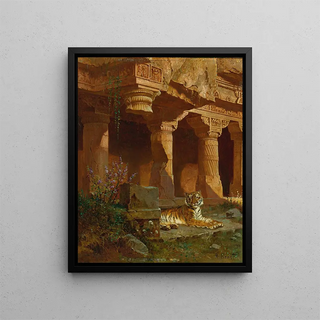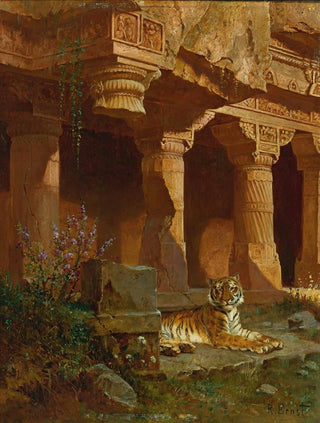Art print | Resting Tiger - Rudolf Ernst


View from behind

Frame (optional)
In the fascinating world of Orientalist art, the artwork "Tigre au Repos" by Rudolf Ernst stands out for its elegance and depth. This painting, which evokes a suspended moment in time, transports us to the heart of an exotic landscape where the majesty of the tiger blends with the richness of oriental motifs. The scene, imbued with serenity, invites contemplation and escape, making this piece a true window into a distant world. Through this art print, the viewer is invited to an immersive experience, allowing them to appreciate the wild beauty and delicacy of the details that compose this captivating scene.
Style and uniqueness of the artwork
Rudolf Ernst's work is characterized by meticulous style and particular attention to detail. In "Tigre au Repos," the shades of warm colors, ranging from ochres to golds, create a warm and welcoming atmosphere. The majestic and peaceful tiger is depicted with remarkable precision, each hair of its fur seeming to vibrate under the light. The background, rich in oriental motifs, emphasizes the exoticism of the scene and reinforces the impression of a haven of peace. The choice of decorative elements, such as rugs and cushions, reflects harmony between nature and craftsmanship, a duality that the artist masters with brilliance. This artwork thus proves to be a true homage to the beauty of fauna and oriental culture, capturing the very essence of a moment of tranquility.
The artist and his influence
Rudolf Ernst, Austrian-born painter, is recognized for his ability to merge Western and Eastern influences in his works. His passion for travel and discovering new cultures profoundly shaped his artistic style. By immersing himself in oriental traditions, Ernst was able to translate landscapes and scenes of daily life with a unique sensitivity. His realistic approach, combined with a romantic touch, allows him to create compositions that tell stories while celebrating the beauty of nature. The influence of Orientalism in his work paved the way for many artists, and his legacy end

Matte finish

View from behind

Frame (optional)
In the fascinating world of Orientalist art, the artwork "Tigre au Repos" by Rudolf Ernst stands out for its elegance and depth. This painting, which evokes a suspended moment in time, transports us to the heart of an exotic landscape where the majesty of the tiger blends with the richness of oriental motifs. The scene, imbued with serenity, invites contemplation and escape, making this piece a true window into a distant world. Through this art print, the viewer is invited to an immersive experience, allowing them to appreciate the wild beauty and delicacy of the details that compose this captivating scene.
Style and uniqueness of the artwork
Rudolf Ernst's work is characterized by meticulous style and particular attention to detail. In "Tigre au Repos," the shades of warm colors, ranging from ochres to golds, create a warm and welcoming atmosphere. The majestic and peaceful tiger is depicted with remarkable precision, each hair of its fur seeming to vibrate under the light. The background, rich in oriental motifs, emphasizes the exoticism of the scene and reinforces the impression of a haven of peace. The choice of decorative elements, such as rugs and cushions, reflects harmony between nature and craftsmanship, a duality that the artist masters with brilliance. This artwork thus proves to be a true homage to the beauty of fauna and oriental culture, capturing the very essence of a moment of tranquility.
The artist and his influence
Rudolf Ernst, Austrian-born painter, is recognized for his ability to merge Western and Eastern influences in his works. His passion for travel and discovering new cultures profoundly shaped his artistic style. By immersing himself in oriental traditions, Ernst was able to translate landscapes and scenes of daily life with a unique sensitivity. His realistic approach, combined with a romantic touch, allows him to create compositions that tell stories while celebrating the beauty of nature. The influence of Orientalism in his work paved the way for many artists, and his legacy end






